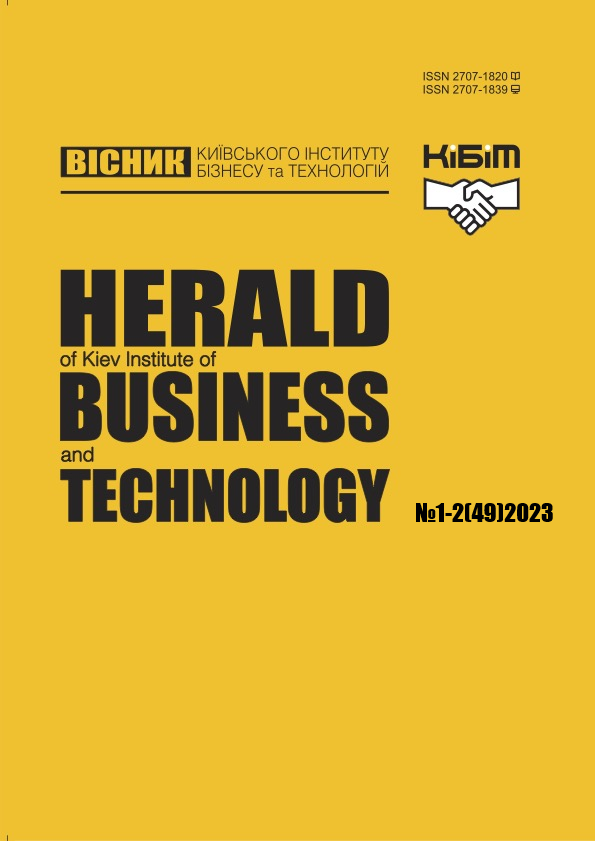SOFTWARE TESTING IN 2023: NEW TRENDS AND CHALLENGES
Abstract
The article clarifies the specifics of the software of 2023, in particular, reveals the peculiarities of combining adaptation and innovation to meet the changing environment of software development. Research in the field of software testing has delved into various aspects of a comprehensive problem, laying the foundation for further study and innovation in practice to increase the efficiency and accuracy of testing, create intelligent test scenarios, predictive analysis of defects, optimization of testing, which will reduce manual labor, accelerate test execution and detect defects at early stages of the development life cycle.
The work highlights modern trends in software testing (artificial intelligence and machine learning in test automation, implemented in the generation of test scenarios, predictive analytics and optimization of test execution; continuous testing and DevOps, actualized in automated, parallel, distributed pipeline testing and shift testing (left; integration of blockchain technology into secure software testing, including test data management, secure collaboration, and audit logs); clarifies the main problems and risks of the industry (quality and reliability risks include comprehensive and continuous testing and Shift-Left testing, security risks – rigorous security testing and ethical hacking, compliance and regulatory risks – documentation, auditing and compliance mechanisms, test environment – infrastructure automation and version control for environments, test automation – test automation strategy, regular maintenance and training and skill development).
Software testing in 2023 is a dynamic industry, constantly evolving at the forefront of technological innovation, playing a critical role in ensuring the quality, reliability and security of software. Constant adaptation, innovation, and commitment to ethical testing practices must be addressed, as software testing will continue to be a driving force in delivering high-quality, secure, and ethical software solutions that shape the digital landscape. The need for the urgent introduction of modern innovations into the Ukrainian field of software testing in order to provide effective software solutions that cover all aspects of life, guaranteeing reliability, safety and functionality, has been proved.
References
2. Bohner, S. A., Marcin, T. & Carlson, M. (2017). How to Use Containers for IoT Device Security. https://www.linux.com/training-tutorials/how-use-containers-iot-device-security/
3. European Parliament and Council (2016). General Data Protection Regulation (GDPR). Official Journal of the European Union.
4. European Parliament and Council (2018). Regulation (EU) 2018/1725 on the protection of natural persons with regard to the processing of personal data by the Union institutions, bodies, offices, and agencies and on the free movement of such data. Official Journal of the European Union.
5. Fowler, M. (2003). Patterns of Enterprise Application Architecture. Addison-Wesley Professional.
6. Fowler, M. & Highsmith, J. (2001). The Agile Manifesto. https://agilemanifesto.org/
7. Garousi, V., Felderer, M., Mäntylä, M. V. & Kuhrmann, M. (2019). What practitioners expect of machine learning-based automated testing. Empirical Software Engineering. 24(6). 3633–3667.
8. Gelperin, D. & Hetzel, W.C. (1983). The Growth of Software Testing. ACM Computing Surveys (CSUR). 15(3). 211–220.
9. Gruver, M. Young, S. & Macias, T. (2017). Continuous Testing for DevOps Professionals. Pearson.
10. International Software Testing Qualifications Board (2018). ISTQB Glossary of Testing Terms. ISTQB.
11. International Software Testing Qualifications Board (2019). ISTQB Certified Tester Foundation Level Syllabus. ISTQB.
12. IoT World Today (2023). IoT Testing Strategies: The Full Guide. https://www.iotworldtoday.com/2022/07/28/iot-testing-strategies-the-full-guide/
13. ISO/IEC/IEEE. (2011). IEEE Standard Glossary of Software Engineering Terminology. IEEE.
14. IT Governance (2023). The GDPR (General Data Protection Regulation) guide. https://www.itgovernance.eu/gdpr-guide
15. Kaser, D. B. & Lemire, D. (2016). Compressed bitmap indexes: beyond unions and intersections. Software: Practice and Experience. 46(6). 723–764.
16. Kasyanov, I. & Zubkov, V. (2017). Application of Blockchain Technology in Cybersecurity. In 2017 10th International Conference on Security of Information and Networks (SIN); IEEE. 267–273.
17. Kruse, R. (2019). Ethical Hacking and Penetration Testing Guide. CRC Press.
18. Microsoft (2023). Introduction to Infrastructure as Code (IaC). Microsoft Docs. https://docs.microsoft.com/en-us/azure/developer/terraform/intro-to-iac
19. Microsoft (2023). What is Quantum Computing? Microsoft Quantum. https://learn.microsoft.com/en-us/azure/quantum/overview-what-is-quantum-computing
20. National Institute of Standards and Technology (NIST). (2017). NIST Special Publication 800-53: Security and Privacy Controls for Federal Information Systems and Organizations. U.S. Department of Commerce.
21. New England Complex Systems Institute. (2023). What is AI? https://necsi.edu/what-is-ai
22. OWASP (2022). OWASP Top Ten. Open Web Application Security Project. https://owasp.org/www-project-top-ten/
23. OWASP (2023). OWASP ZAP. Open Web Application Security Project. https://owasp.org/www-project-zap/
24. Pethuru Raj, C. & Anuragam, A. (2019). IoT Testing for Beginners: Learn the Basics of IoT Testing. Apress.
25. Python Software Foundation. (2023). Docker (Python client). PyPI. https://pypi.org/project/docker/
26. Shannon, C. E. (1948). A Mathematical Theory of Communication. The Bell System Technical Journal. 27(3). 379–423.
27. Shrestha, R. & Ali Babar, M. (2019). A Systematic Mapping Study on Blockchain Testing. In Proceedings of the ACM/IEEE 22nd International Conference on Model Driven Engineering Languages and Systems; ACM. 98–107.
28. The New Stack (2023). Shift-Left and Shift-Right: The Testing Conversation. https://thenewstack.io/shift-left-and-shift-right-the-testing-conversation/





